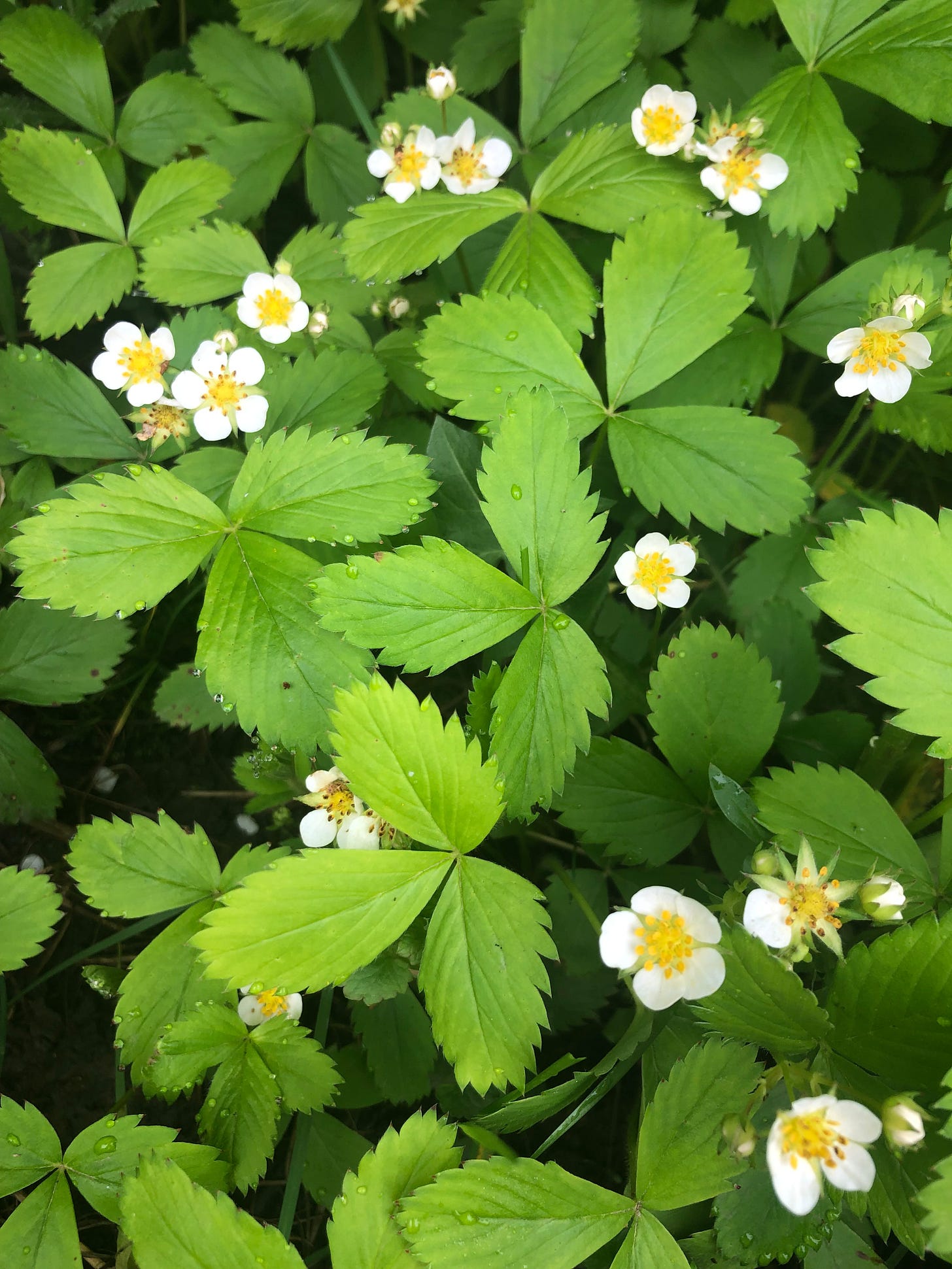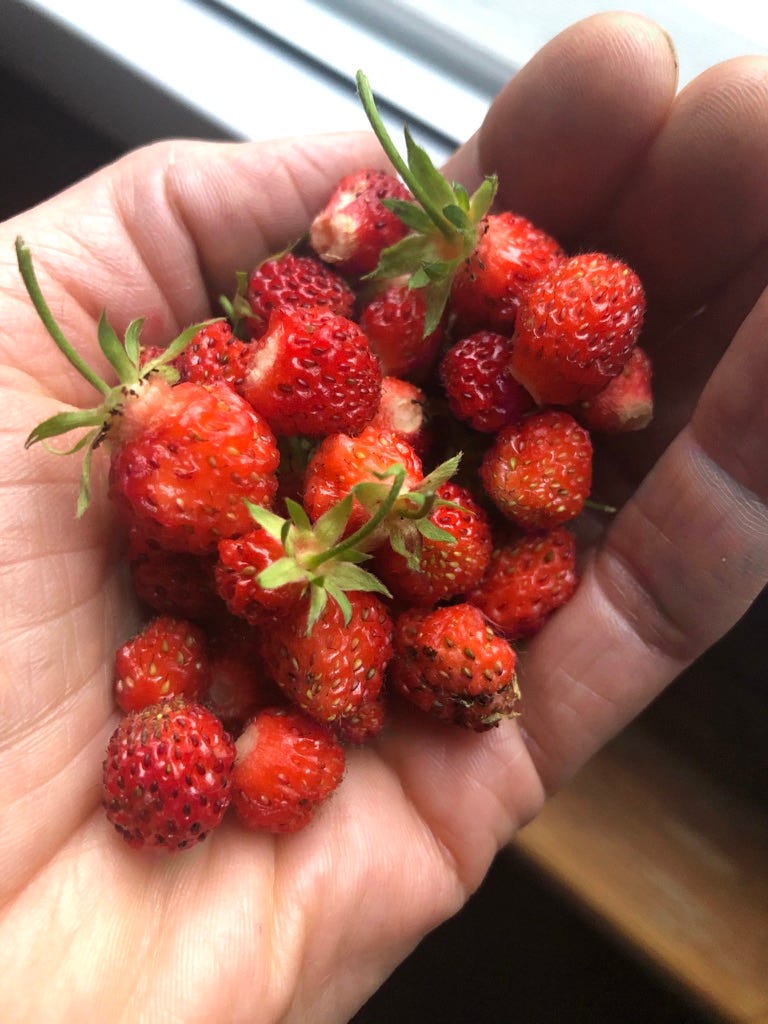When the Wild Strawberry starts to bloom, the little white flowers call out to me and draw me in. They bring me such joy this time of year. Growing in patches in grassy areas around the farm, under trees and along the forest edge, it is native to North America. Its properties are similar to the Woodland Strawberry (Fragaria vesca) used in the European herbal tradition. Wild Strawberry grows quite prolifically in our region tolerating sun to part shade. Best propagated by digging up its runners and transplanting, it does not propagate well from seed. The fruits, flowers, leaves and roots can all be used medicinally. I love to dry its leaves and flowers to add to my nourishing tea blends. It yields tiny flavourful berries a little further along in the season. Cultivated strawberries are hybrid of Wild Strawberry (Fragaria virginiana) and Coastal or Chilean Strawberry (Fragaria chiloensis).
Much of my understanding of wild strawberry comes to me from the writings of one of my favourite authors Matthew Wood. He shares that the small wild fruit is associated in Ojibwe culture, via its shape, with the heart and womb.1 In many indigenous cultures across North America, Wild Strawberry is sacred. Referred to as the “Heart Berry”, it teaches forgiveness and peace, as well as a commitment to caring for others from birth to death. The elders say “Just as the heart berry is connected to the strawberry plant by a vast system of leaves, runners and roots, so is the heart connected to all the organs and parts of the human body. The heart is the centre of the human”. Considered in many cultures to be a woman’s medicine, it is associated with the uterus and forms an important part of traditions of initiation into womanhood in Ojibwe culture. Wild strawberry is used in indigenous North American cultures to treat digestive disorders, skin problems and to strengthen the uterus during and after pregnancy. 2
Just as we may associate eating too many strawberries with causing a skin rash or other allergic symptoms, Wild Strawberry can also be used medicinally to help address allergic symptoms. If you know you are sensitive to strawberries, this herb is not for you, however you might consider its use in homeopathic dilution.
Its cooling, moist and mildly astringent qualities help allay allergic symptoms. These allergic symptoms may include skin rashes such as hives; redness and inflammation of the eyes; sneezing; red, swollen or inflamed tongue.
Underlying allergies we often see issues with the gut. Wild strawberry has a particular affinity in reducing inflammation in the gut, making it useful in stomach disorders as well as diarrhea. The homeopathic literature speaks of its use in worms (parasites), as well as its affinity to the mesenteric glands, (the GALT or gut associated lymphoid tissue), making it an important remedy in addressing the underlying issues that are often at the root of allergic patterns in the body. “Recent work shows that the mesenteric lymph nodes (MLNs) are the key site for tolerance induction to food proteins and that they also act as a firewall to prevent live commensal intestinal bacteria from penetrating the systemic immune system”.3
Its diuretic effect supports kidney function and has been found helpful in edema. It can reduce tendency to urinary tract infections, gout and kidney stones. It helps strengthen the gums and I have seen the leaves and flowers helpful in reducing tartar from teeth when taken internally as tea over time.
In the realm of the subtle emotional body, the person needing Wild Strawberry may struggle with “great sadness, often without knowing why. It helps clear fears. Where they are too frightened to even voice it. The remedy brings joy, light heartedness, peace and confidence”.4 Massimo adds that it can be helpful in those who are extremely sympathetic and compassionate where the misfortune of others affects them greatly.
When using Wild Strawberry, keep in mind that the root is much stronger in its astringent qualities, whereas the leaves and flowers are more nourishing, moistening and mucilaginous. As long as you are not sensitive to strawberries, I consider the leaves and flowers to be nutritive and food like. If you have access to unsprayed cultivated strawberry leaves, by all means they can be used similarly.
Earthwise Herbal Volume 1, Matthew Wood
Wabano Centre Resources https://wabano.com/product/strawberry-teachings/
https://pubmed.ncbi.nlm.nih.gov/16533891/
Repertory of Provings by Susan Palmer





